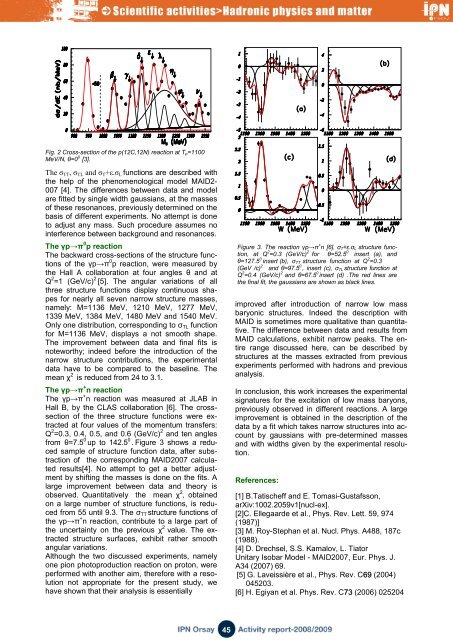exotic nuclei structure and reaction noyaux exotiques ... - IPN - IN2P3
exotic nuclei structure and reaction noyaux exotiques ... - IPN - IN2P3
exotic nuclei structure and reaction noyaux exotiques ... - IPN - IN2P3
You also want an ePaper? Increase the reach of your titles
YUMPU automatically turns print PDFs into web optimized ePapers that Google loves.
Fig. 2 Cross-section of the p(12C,12N) <strong>reaction</strong> at T p =1100<br />
MeV/N, θ=0 0 [3].<br />
The σ TT , σ TL <strong>and</strong> σ T +ε.σ L functions are described with<br />
the help of the phenomenological model MAID2-<br />
007 [4]. The differences between data <strong>and</strong> model<br />
are fitted by single width gaussians, at the masses<br />
of these resonances, previously determined on the<br />
basis of different experiments. No attempt is done<br />
to adjust any mass. Such procedure assumes no<br />
interference between background <strong>and</strong> resonances.<br />
The γp→π 0 p <strong>reaction</strong><br />
The backward cross-sections of the <strong>structure</strong> functions<br />
of the γp→π 0 p <strong>reaction</strong>, were measured by<br />
the Hall A collaboration at four angles θ <strong>and</strong> at<br />
Q 2 =1 (GeV/c) 2 [5]. The angular variations of all<br />
three <strong>structure</strong> functions display continuous shapes<br />
for nearly all seven narrow <strong>structure</strong> masses,<br />
namely: M=1136 MeV, 1210 MeV, 1277 MeV,<br />
1339 MeV, 1384 MeV, 1480 MeV <strong>and</strong> 1540 MeV.<br />
Only one distribution, corresponding to ζ TL function<br />
for M=1136 MeV, displays a not smooth shape.<br />
The improvement between data <strong>and</strong> final fits is<br />
noteworthy; indeed before the introduction of the<br />
narrow <strong>structure</strong> contributions, the experimental<br />
data have to be compared to the baseline. The<br />
mean χ 2 is reduced from 24 to 3.1.<br />
The γp→π + n <strong>reaction</strong><br />
The γp→π + n <strong>reaction</strong> was measured at JLAB in<br />
Hall B, by the CLAS collaboration [6]. The crosssection<br />
of the three <strong>structure</strong> functions were extracted<br />
at four values of the momentum transfers:<br />
Q 2 =0.3, 0.4, 0.5, <strong>and</strong> 0.6 (GeV/c) 2 <strong>and</strong> ten angles<br />
from θ=7.5 0 up to 142.5 0 . Figure 3 shows a reduced<br />
sample of <strong>structure</strong> function data, after substraction<br />
of the corresponding MAID2007 calculated<br />
results[4]. No attempt to get a better adjustment<br />
by shifting the masses is done on the fits. A<br />
large improvement between data <strong>and</strong> theory is<br />
observed. Quantitatively the mean χ 2 , obtained<br />
on a large number of <strong>structure</strong> functions, is reduced<br />
from 55 until 9.3. The ζ TT <strong>structure</strong> functions of<br />
the γp→π + n <strong>reaction</strong>, contribute to a large part of<br />
the uncertainty on the previous χ 2 value. The extracted<br />
<strong>structure</strong> surfaces, exhibit rather smooth<br />
angular variations.<br />
Although the two discussed experiments, namely<br />
one pion photoproduction <strong>reaction</strong> on proton, were<br />
performed with another aim, therefore with a resolution<br />
not appropriate for the present study, we<br />
have shown that their analysis is essentially<br />
Figure 3. The <strong>reaction</strong> γp→π + n [6]. σ T +ε.σ L <strong>structure</strong> function,<br />
at Q 2 =0.3 (GeV/c) 2 for θ=52.5 0 insert (a), <strong>and</strong><br />
θ=127.5 0 insert (b), σ TT <strong>structure</strong> function at Q 2 =0.3<br />
(GeV /c) 2 <strong>and</strong> θ=97.5 0 , insert (c), σ TL <strong>structure</strong> function at<br />
Q 2 =0.4 (GeV/c) 2 <strong>and</strong> θ=67.5 0 insert (d) .The red lines are<br />
the final fit, the gaussians are shown as black lines.<br />
improved after introduction of narrow low mass<br />
baryonic <strong>structure</strong>s. Indeed the description with<br />
MAID is sometimes more qualitative than quantitative.<br />
The difference between data <strong>and</strong> results from<br />
MAID calculations, exhibit narrow peaks. The entire<br />
range discussed here, can be described by<br />
<strong>structure</strong>s at the masses extracted from previous<br />
experiments performed with hadrons <strong>and</strong> previous<br />
analysis.<br />
In conclusion, this work increases the experimental<br />
signatures for the excitation of low mass baryons,<br />
previously observed in different <strong>reaction</strong>s. A large<br />
improvement is obtained in the description of the<br />
data by a fit which takes narrow <strong>structure</strong>s into account<br />
by gaussians with pre-determined masses<br />
<strong>and</strong> with widths given by the experimental resolution.<br />
References:<br />
[1] B.Tatischeff <strong>and</strong> E. Tomasi-Gustafsson,<br />
arXiv:1002.2059v1[nucl-ex].<br />
[2]C. Ellegaarde et al., Phys. Rev. Lett. 59, 974<br />
(1987)]<br />
[3] M. Roy-Stephan et al. Nucl. Phys. A488, 187c<br />
(1988).<br />
[4] D. Drechsel, S.S. Kamalov, L. Tiator<br />
Unitary Isobar Model - MAID2007, Eur. Phys. J.<br />
A34 (2007) 69.<br />
[5] G. Laveissière et al., Phys. Rev. C69<br />
(2004)<br />
045203.<br />
[6] H. Egiyan et al. Phys. Rev. C73<br />
(2006) 025204<br />
45

















